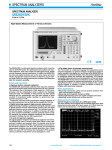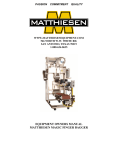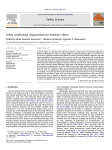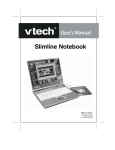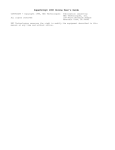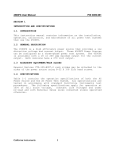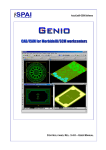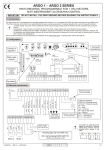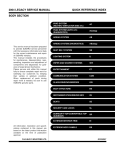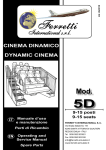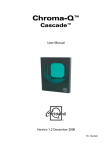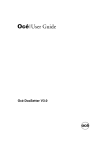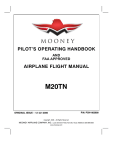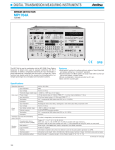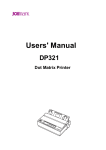Download JP 883
Transcript
Printer JP 883 User’s Manual The mark affixed to the product certifies that the product satisfies the basic quality requirements. Your attention is drawn to the following actions that could compromise the characteristics of the product: • incorrect electrical supply; • incorrect installation; incorrect or improper use, or, in any case, not in accordance with the warnings given in the User Manual supplied with the product; • replacement of original components or accessories with others of a type not approved by the manufacturer, or carried out by unauthorized personnel. Use a clean, dry, lint-free cloth to clean the printer. Do NOT use alcohol, solvents or other abrasive cleaners. Always disconnect the power cable plug from the electrical power supply. Do not spill water or other liquids on or in the printer. NOTE: This equipment has been tested and found to comply with the limits for a CLASS B digital device pursuant to Part 15 of the FCC Rules. These limits are designed to provide reasonable protection against harmful interference in a residential installation. This equipment generates, uses and can radiate radio frequency energy and, if not installed and used in accordance with the instructions, may cause harmful interference to radio communications. However, there is no guarantee that interference will not occur in a particular installation. If this equipment does cause harmful interference to radio or television reception, which can be determined by turning the equipment off and on, the user is encouraged to try to correct the interference by one or more of the following measures: . Reorient or relocate the receiving antenna. . Increase the separation between the equipment and receiver. . Connect the equipment into an outlet of a circuit different from that to which the receiver is connected. . Consult the dealer or an experienced radio/TV technician for assistance. Changes or modifications not expressly approved by the party responsible for compliance could void the user’s authority to operate the equipment. Connection of peripherals requires the use of grounded shielded signal cables. This digital equipment does not exceed the CLASS B limits for radio noise emissions from digital apparatus set out in the interference-causing equipment standard entitled “Digital Apparatus”, ICES-003 of the Industry Canada. Ce dispositif numérique respecte les limites bruits radioélectriques applicables aux appareils numériques de CLASSE B prescrites dans la norme sur le matériel brouilleur : “Appareils Numériques”, NMB-003 édictée par le ministère des Communications. Trademarks and/or proprietary names indicated are the property of their respective owners. JP 883 This manual describes how to install your printer and prepare it for use. It also contains information on day-to-day use and care of your printer. The initial installation procedure consists of a sequence of operations which should be performed in the order described. You will find further information about the printer features and functions in the On-Line Help on the diskettes supplied with the printer. Supplies and Optional Items The following items can be ordered from your computer dealer. They are packed individually and have their own specific instructions leaflets. Print heads and ink cartridges Disposable high-quality four-colour print head) B0205 M Disposable monochrome (black) print head B0046 G Monochrome print head with replaceable ink cartridge: blister pack containing a complete monochrome ink jet print head (outer casing with cartridge inserted) and two spare cartridges B0047 H Blister pack containing 2 monochrome ink cartridges B0048 J Optional economy colour print head with replaceable colour ink cartridge: blister pack containing a complete colour ink jet print head (outer casing with cartridge inserted) and two spare cartridges B0044 E Blister pack containing 2 four-colour ink cartridges for optional economy colour print head B0045 F Printing media Description Format Contents Code Plain paper A4 500 sheets B0187 T Coated paper A4 100 sheets B0093 Y Glossy paper A4 20 sheets B0035 V Photo glossy paper A4 20 sheets B0090 H Transparency film A4 20 sheets B0036 W T-shirt transfers A4 5 sheets B0094 Z Optional items Serial interface kit for EIA RS 232C/V24 interface 01306 R Print head container B0213 C Table of contents Installation Guide . . . . . . . . . . . . . . . . . . . . . . . . . . . 1 Unpacking . . . . . . . . . . . . . . . . . . . . . . . . . . . . . Location . . . . . . . . . . . . . . . . . . . . . . . . . . . . . . Connecting your printer . . . . . . . . . . . . . . . . . . . . . . Switching on your printer . . . . . . . . . . . . . . . . . . . . . Mounting the document support for the multiple document feeder Mounting the document support for the single document feeder . Mounting the document output tray . . . . . . . . . . . . . . . . Inserting the print heads . . . . . . . . . . . . . . . . . . . . . . Loading documents in the printer . . . . . . . . . . . . . . . . . Installing the printer software . . . . . . . . . . . . . . . . . . . Preparing your printer using the Printer Monitor . . . . . . . . . . . . . . . . . . . . . . . . . . . . . . . . . . . . . . . . . . . . . . . . . . . . . .1 .1 .2 .2 .3 .3 .3 .4 .6 .7 .8 Troubleshooting . . . . . . . . . . . . . . . . . . . . . . . . . . 10 Disinstalling the printer driver . . . . . . . . . . . . . . . . . . . . . . . 11 Printer operator panel . . . . . . . . . . . . . . . . . . . . . . . 12 Buttons - basic functions . . . . . . . . . . . . . . . . . . . . . . . . . 12 Buttons - special functions . . . . . . . . . . . . . . . . . . . . . . . . . 12 Light indicator . . . . . . . . . . . . . . . . . . . . . . . . . . . . . . . 13 Embossed templates . . . . . . . . . . . . . . . . . . . . . . . . 14 On-line Guide . . . . . . . . . . . . . . . . . . . . . . . . . . . . 14 More about print heads . . . . . . . . . . . . . . . . . . . . . . 15 Replacing the print heads . . . . Replacing the ink cartridge . . . Print head care and precautions Print head container . . . . . . . . . . . . . . . . . . . . . . . . . . . . . . . . . . . . . . . . . . . . . . . . . . . . . . . . . . . . . . . . . . . . . . . . . . . . . . . . . . . . . . . . . . . 15 16 18 19 More about paper and special printing media . . . . . . . . . . 20 Loading documents . . . . . . . . . . . . . . . . . . . . . . . . . . . . 20 Output support for envelopes, narrow documents and photographs . . . 23 Document types . . . . . . . . . . . . . . . . . . . . . . . . . . . . . . 24 DOS environment . . . . . . . . . . . . . . . . . . . . . . . . . . 25 Product Characteristics . . . . . . . . . . . . . . . . . . . . . . 27 Guarantee Table of contents Installation Guide Unpacking Keep the carton and all the packing materials in case you have to repack or ship the printer. As soon as you have unpacked the printer and its accessories, check that all the parts ordered have been delivered and are undamaged. As well as this booklet, the packing carton should also contain: A - Printer B - Power cable D - Manual feeder document support F - Two ink jet print heads (Colour and Black) C - Transparent document support E - Output tray G - Driver diskette(s) If anything is missing or damaged, call your local retailer immediately. The interface cable for connecting the printer to your PC is NOT supplied with the printer. Location 1. Place the printer on an ample, stable surface near your computer. 2. Make sure that there is enough space around the printer for all its parts to be accessed comfortably. 3. Make sure that there is a convenient independent electrical power supply socket to which you can connect the printer. 4. Do NOT leave the printer exposed to direct sunlight or heat sources, or in dusty, dirty or poorly ventilated environments. Installation Guide 1 Connecting your printer To the electrical power supply To your computer Before plugging into the power supply socket, make sure the printer is on a stable surface, that its cover is closed and read the following warning carefully. To connect your printer to your PC you require a standard, bi-directional IEEE 1284-type inferface cable. The interface cable is NOT supplied with the printer. Make sure the electrical power supplies the voltage indicated on the electrical data plate on the rear of the printer. If the electrical data plate indicates a different voltage, call your local retailer i m m e d i a t e l y . D O N O T, U N D E R A N Y CIRCUMSTANCES, CONNECT THE PRINTER TO THE ELECTRICAL POWER SUPPLY. Make sure that neither your printer nor your PC are powered. 1. Plug the interface cable connector into the socket on the rear of the printer and close the spring clips on it. Make sure that the plug on the power cable of the printer is of the type accepted by the wall socket you intend to use; if it is not, call your local retailer. Do NOT attempt to change the plug yourself. The manufacturer declines all responsibility for accidents to persons or damage to the printer arising from the non-observance of this warning. 1. Insert the small two-pin connector of the printer power cable in the socket on the rear of the printer. 2. Connect the other end of the interface cable to the appropriate interface connector socket (port) on your computer/host system. Switching on your printer Press the “POWER” button on the printer operator panel. The printer will take a few moments to execute a series of internal checks (there will be some mechanical movement), after which it will be in STANDBY condition (the light indicator lit). POWER PAPER 2. Plug the other end of the cable into a wall socket. The socket outlet shall be installed near the equipment and shall be easily accessible. 2 After approximately two minutes of inactivity, the printer will go into “sleep” mode with the print head carriage in its rest position at the right hand margin. Installation Guide Mounting the document support for the multiple document feeder Mounting the document output tray With the rounded part of the guide as the top edge, insert the document support in the slot on the rear of the multiple document feeder so that it slides completely into the casing. With the flat end towards the printer and the lip at the opposite end facing upwards, insert the document output tray under the front of the printer, making sure the holes on the tray arms fit on to the notches on the printer base. Mounting the document support for the single document feeder The tray has an adjustable centre panel which should be extended according to the document format you are using (standard format sizes A4, Letter and Legal are marked on the panel). With the adjustable margin guide to the front left, insert the document support in the front of the multiple document feeder so that it sits in the grooves and forms a second document insertion channel for single documents. Installation Guide 3 Inserting the print heads The print head carriage on your printer is designed to hold two types of print head: monochrome black, on the left and colour on the right. The two print heads supplied with your printer are both disposable: once they are empty they MUST be replaced (see the specific section in More about print heads). 4. Open the printer cover. The print head carriage will move automatically to the loading position for the monochrome print head (left hand chamber) and the light indicator starts flashing rapidly. BOTH print heads MUST be installed BEFORE attempting any printing operation. To insert the print heads, proceed as follows: 1. Make sure the printer is powered - the light indicator should be lit (if it is not, press the POWER button on the printer operator panel). 2. Open the sealed print head container of the monochrome print head and remove the print head, holding it by the thumb and finger grip (end opposite the protective film). 5. With the electrical contacts (gold-coloured part) towards the corresponding contacts in the housing on the print head carriage, insert the print head in its chamber. 3. Remove the protective film. Take care not to touch the electrical contacts (gold-coloured part) in the print head chamber. Do not touch either the electrical contacts (gold-coloured part) or the printing nozzles nor sit the print head on either of them. 4 6. Push the print head towards the rear of the printer to fix it in place. Installation Guide 7. Press PAPER on the printer operator panel. The print head carriage moves to the colour print head loading position (right hand chamber). 8. Repeat points 2, 3, 5, 6 of this paragraph to insert the colour print head. 9. Before closing the printer cover, press and hold the PAPER button and press the POWER button for at least two seconds, to signal that new print heads have been inserted. The light indicator will flash three times in acknowledgment and the printer will then be in standby condition. See “Replacing the print head”, “Replacing the ink cartridge” and “Print head care” in More about print heads for further details on the handling, substitution and care of the print heads. Installation Guide 5 Loading documents in the printer 1. Pull up document support on the rear of the multiple document feeder to support the document format you are loading and make sure that the left margin guide on the multiple document feeder is at the physical left hand margin. 5. Press PAPER on the printer operator panel. The first document is inserted to the first print position. Press PAPER again, to make sure that the document feeds smoothly through and exits from the printer without crushing or skewing. 2. Fan the documents thoroughly. 3. Align the documents against the physical right margin and load them into the multiple document feeder, inserting them carefully until them stop inside the printer. The multiple document feeder can contain up to 120 x 80 g/m2 sheets of plain paper. For other types and sizes of documents and envelopes, see “Product Characteristics” in this manual and the specific topic in the On-Line Guide loaded when you install your printer driver. Do NOT add paper to that already in the multiple sheet feeder; always remove any existing paper and fan it together with the paper to be loaded. 4. Position the left guide against the left edge of the paper. 6 Installation Guide Installing the printer software q Before installing your printer software Software installation procedure The diskette(s) supplied with your printer contain a high quality colour and monochrome printing system for both Windows® 3.1/3.11 and Windows® 95 environments. The installation procedure varies, depending on the Windows® environment installed on your PC. This printing system includes : 1. Insert the printer driver diskette in drive A (usually) of your PC. • a printer driver which gives you access to all the printer features through easy-to-use property sheets, • a printer monitor for easy access to Printing Status and Printer Care, • on-line documentation, • an “uninstall” programme, to remove the printer software, should a re-installation be necessary. The diskettes also contain a printer set-up utility programme (CONFIG.EXE), for personalised printer settings under DOS if necessary (see “DOS environment”). Before installing any printer driver, we strongly recommend that you make a back-up copy of the original diskettes (according to “Terms and conditions of the user license” included with the diskettes) and then use this copy for the installation procedure. This will allow you to keep the original diskettes as masters so that, should any problem arise with the back-up copy, you can make another copy. q Minimum system requirements • From Windows® 3.1 up to Windows® 95, • PC 486 or later with at least 4 MBytes of RAM, • 4 MByte of free disk space. Installation Guide q Windows® 3.1/3.11 2. Activate Windows® 3.1/3.11 (if it is already running, make sure that all Windows applications are closed before starting to install the driver; if necessary, consult your Windows® user documentation). 3. Activate the Control Panel in the Main window, clicking twice with your mouse indicator on the corresponding icons. 4. Select the Printers icon in the same way. 5. If the Installed Printers box is empty, click on Install... . 6. If the Installed Printers box already contains one or more driver names, click on Add>>, select Install Unlisted or Updated Printer in the List of Printers and then click on Install... . 7. Check that the Install Driver window already indicates the drive (usually A) in which you have inserted the driver diskette, otherwise click on the drive name and change it, using your PC keyboard. 8. Click on OK. 9. T h e Add Unlisted or Updated Printer window contains the list of drivers present on the diskette. Select the driver with your printer name and click on OK. 10. Your driver is now installed and your printer name appears in the List of Printers. 11. With your printer name highlighted, click on Set as Default Printer button, so that your printer will active in all your Windows® applications. 7 12. Check you printer connection by clicking on the Connect... button. By default, your printer will be connected to the LPT1 port which corresponds to the hardware connection of a parallel interface cable. 13. Click on the Close button in the Printers dialogue box. A group window with the driver name will be created automatically. It allows immediate access to the Spool Manager, the Printer Monitor, the On-line Documentation and information files whenever these are required. q Windows® 95 The Microsoft Windows® 95 operating system allows automatic installation of peripherals through the Plug & Play feature, a bi-directional communication and hardware recognition procedure. 1. Make sure that both printer and PC are powered. The printer must NOT be in error mode, i.e. the indicator light must not be flashing. 2. Activate Microsoft Windows® 95. If already started, execute the “Shut down” command and restart your computer. 3. A window, indicating that a new peripheral has been detected (New Hardware found and the printer name) is displayed. as the Default printer. If other printer drivers are already installed, and you wish to install the current one as the default printer, click Yes and then the Finish button. The installation of the driver files will start. 6. At the end of the installation, you will be asked to remove the diskette and restart Windows. You can also install the printer driver using the “Add Printer” feature in Printers in the Settings folder. In this case, your printer need not be connected to your PC. In both cases, a folder with the driver name will be created automatically in the Programs folder. It allows easy access at any time to the Printer Monitor, the On-line Documentation, Disinstall programme and information files whenever these are required. Preparing your printer using the Printer Monitor The Printer Monitor is an on-screen aid with an extensive, user-friendly HELP feature. It contains a series of functions that are designed to help you during daily use of the printer. It can be viewed by clicking on the specific icon and allows you to: • view the printer operating status on your PC screen during a print job. It indicates the proportion of the document printed and eventual error messages (Status), The same window shows the Driver from disk provided by hardware manufacturer option already highlighted. Click the OK button. • perform printer care functions, to maintain 4. With the Install from Disk window displayed, insert the driver diskette in the drive selected, specify this drive if requested and click OK. Once you have installed the printer software from the diskette(s) supplied, you must prepare your printer by performing a number Printer Care functions contained in the Printer Monitor. optimum working conditions (Printer Care). 5. T h e Add Printer Wizard w i n d o w i s displayed. If there are no printer drivers already installed on your system, your printer will be installed 8 Installation Guide How to access the Printer Monitor q Under Windows® 3.1/3.11: You can access the Printer Monitor from your printer driver group at any time, by doubleclicking its icon. q Under Windows® 95: You can access the Printer Monitor in either of the following ways: (a) Click Start, highlight Programs and then the printer name in the sub-menu which opens. (b) Click the Printer Monitor icon. OR: (a) Click Start, highlight Settings, and then click Printers in the sub-menu which opens. (b) Click your printer name to highlight it. T h e Printer Care tab also has two other functions: q Cleaning the print head (Clean) If you notice a deterioration in the print quality, before changing the print head or replacing the ink cartridge, run the “Clean” function. 1. Click the printer monitor icon, then the Printer Care tab, (if necessary). 2. Click the Clean button, then follow the instructions displayed. q Running the print test (Test) The print test gives you a print-out of the printer’s functional characteristics (firmware release, print head tests, current settings). (c) Click your right mouse button. 1. Click the printer monitor icon, then the Printer Care tab, (if necessary). (d) Select the option “Run the Printer Monitor” in the menu which opens. 2. Click the Test button, then follow the instructions displayed. With the Printer Monitor displayed on your PC screen, click the Printer Care tab: 1. Click on both the “New Print Head” check boxes ONLY if you did NOT press POWER and PAPER when you inserted the print heads. 2. Click the Align button, to check the accuracy of bidirectional printing; follow the instructions displayed. 3. Click the Demo button, to print the demo page; follow the instructions displayed. Once you have completed these operations, you can reduce the Printer Monitor to an icon. Installation Guide Your printer is now ready for use. If you have had problems with any of the printer installation procedures, check that you have followed the instructions as given. If a repetition of the instructions is unsuccessful, see the appropriate topic in the Troubleshooting section that follows. If you have problems with any operating procedure, or are unable to perform a specific function, always check that you have followed the instructions as given. If a repetition of the inst ruct ions is unsuccessful, see the appropriate section in “Troubleshooting” in the On-line Guide loaded with the printer driver. 9 Troubleshooting Your printer is designed to require only minimum maintenance, however, everyday use will give rise to a num ber of simple printer-care operations. During normal printer operation, an error condition will be signalled by the rapid flashing of the light indicator and the positioning of the print head carriage to indicate whether the error is due a paper or print head malfunction. If you are unable to run the operation you require, first check that you have followed correctly the instructions given in this manual or the section “How to...” in the On-Line Guide. If, after repeating the procedure, you still have a problem, consult the specific topic in Troubleshooting in the On-Line Guide. If you detect serious mechanical damage to or a failure in the printer, do not attempt to repair it yourself! CALL THE TECHNICAL SUPPORT SERVICE. q Transportation • Always make sure that the print head is in its rest position. To ensure this, always press POWER to switch off your printer BEFORE switching off your PC. • Take care not to drop your printer. • Repack your printer in its original carton, whenever possible. Installation q Missing or damaged parts. • Contact your retailer immediately. q Printer is not powered. No power supply (the light indicator is not lit). • Check that the printer is connected properly General care q Environment • Keep your printer in a stabilised, ventilated to the electrical power supply socket. • Press POWER. q No printer reaction. environment (temperature range: 15 to 35 oC - 60 to 95 oF; relative humidity: 20% - 80%). When you press POWER, the print head carriage and the output tray spoilers do not move. • Do not subject your printer to brusque changes in temperature and/or humidity. • Check that the carriage path and the spoilers • Do not let dust accumulate on the printer; use • Try switching the printer off and then on a slightly damp cloth to remove dust. Do NOT use abrasive or corrosive cleaning fluids to clean the printer. 10 are free of impediment. again. • If the light indicator flashes rapidly, there is a failure on the mother board; press POWER to switch the printer off, disconnect it and call the technical support service. Troubleshooting q Demo page/Print test did not run. • Press POWER to switch the printer off, wait a few seconds and then press POWER again. Repeat the correct key sequence (see “Buttons - special functions” i n Printer operator panel or click the appropriate button in the Printer Care tab in the Printer Monitor (see specific item in Printer Monitor. • If the light indicator flashes rapidly: – there is no paper in the printer; follow the instructions given in “Loading documents in the printer ” in the Installation Guide. – the print head/ink cartridge is not inserted correctly or needs replacing; follow the instructions given in “Inserting the print heads” in the Installation Guide, or “Replacing the print head ” and/or “Replacing the ink cartridge” in More about print heads. to your computer documentation and/or contact your computer dealer. • Check that you have configured your application correctly (see the On-Line Guide loaded with your driver, and your application manual). q Printer care functions in Printer Monitor not active If, when you open the Printer Monitor, you find that the Printer Care buttons are not active: • Check that the interface cable is of the correct type. It must be a standard, bi-directional IEEE 1284-type inferface cable. If you have any doubts, contact your computer dealer. • Check that the interface cable is connected correctly both to your printer and to your PC. q Problems with connection to host. • Check that your interface cable is of the correct type. It must be a standard, bi-directional IEEE 1284-type inferface cable. If you have any doubts, contact your computer dealer. • Make sure you have fixed the interface connectors properly both to the printer and to the host. • If your PC is an “ECP”-type PC, check that the printer port setting on it is Printer Port: LPTx. If necessary, change this setting as follows: – right click on the My Computer icon, – select Properties, then Device Manager, Disinstalling the printer driver If you have problems printing that are not solved with normal printer care operations (document and print heads inserted correctly, appropriate selections in the printer driver, etc.), it may be necessary to re-install the printer driver. To do this, you must first disinstall the driver, by clicking on the specific icon created in the printer group when you first loaded the driver. This allows a complete and correct removal of all the files loaded from the diskettes and/or created in your PC during driver installation, permitting a correct re-installation (see “Installing the printer software”). – double click on Ports (COM&LPT). – select Printer Port: LPTx. If Ports (COM&LPT) does not offer a simple LPTx port or if the selection of this port does not solve your problem, you must change the LPT mode setting in your computer BIOS to either [Standard] or [Bi-directional]. For further information on the BIOS setting, refer Troubleshooting For other problems regarding the use of print heads, printing media, etc., refer to the specific topics in the Troubleshooting section of the On-Line Guide loaded with your printer driver. 11 Printer operator panel The behaviour of the buttons and light indicator on the operator panel will depend on the printer’s status. Buttons - special functions q with printer cover closed q Printer states: • standby/sleep: no data to be printed; • printing: from the reception of data until the completion of its printing; • error: when an error has been detected and the printer is waiting for user intervention. Function Button(s) Demo page Power held and Paper pressed three times; then released together The light indicator starts flashing in an three-flash sequence. The demo page is printed, after which the printer returns to standby mode. Print test Power held and Paper pressed once; then released together The light indicator starts flashing in a single on-off sequence. The print test is printed, after which the printer returns to standby mode. Clean print heads Power held and Paper pressed twice; then released together The light indicator starts flashing with a two-flash sequence. A print head cleaning cycle is executed, after which the printer returns to standby mode. Hex dump Power held and Paper pressed five times; then released together The light indicator starts flashing with a five-flash sequence. All subsequent data transmitted to the printer will be printed in its hexadecimal format. This feature should be used only under technical guidance, as it can generate extremely long printouts. • service: user-invoked mode for special functions, independent of host. POWER PAPER Buttons - basic functions Function Button Description Printer on/off Power Toggles the printer ON/ OFF condition. Paper load/ eject Paper Loads/ejects a document in/from the printer. If a document is already present in the p ri nter, causes its expulsion. If there is no document in the printer, causes one to be loaded to the first print position. The printer is in printing status, forces the completion of the current page and expels the document. 12 Description Printer operator panel Buttons - special functions Light indicator q with printer cover open The status of the light indicator indicates the different printer conditions. The print head carriage will be positioned to indicate the type of error on the template embossed on the printer casing (see “Embossed templates”). Function Print head carriage movement New print head/ink cartridge Button(s) Paper Paper held and Power pressed for at least two seconds, then released together Description Toggles the m o n o chrome/colour print head loading position. Signals that a NEW print head an d / or in k ca rtridge has been inserted. The light indicator flashes three times in acknowledgment Status Condition off The printer is not powered. lit The printer is powered. flashing slowly The printer is receiving data. flashing rapidly An error or failure condition has occurred in the printer. Paper out condition. Solution: Load a document and p ress PAPER ( s e e “Loading documents in the printer ” in the Installation Guide). Paper jam condition. Solution: Remove the jammed document (see the specific section in More about paper and special printing media). End of ink condition. Solution: R e p l a c e t h e i n k cartridge or change the entire print head (see the specific items in More about print heads). Failure condition. Switch off the printer and disconnect it from the electrical power supply. Make sure that the print head carriage and paper feed paths are not obstructed and then reconnect and switch on the printer. If the light indicator continues flashing rapidly, disconnect the printer and call the technical support service or your dealer. Printer operator panel 13 Embossed templates On-line Guide Your printer has two embossed instruction templates: one on the printer casing under the cover, the other on the inside of the cover. The diskettes containing the printer software also contain an On-line Guide. This guide contains further information on the printer features, and print head and paper handling. It is structured in two parts: “How do I...” and Troubleshooting. q on the printer casing: • how to move from one print head loading position to the other (see “Buttons - special functions” in Printer operator panel); • the print head carriage position if a “paper out/jam” condition occurs (see specific items in Troubleshooting in the On-line Guide). The information contained in the On-line Guide is organised in “topics”; e.g. “Paper ”, “Print Head ”, etc., and can be printed screen by screen or by topic. To access the On-line Guide, click on the specific icon in the Printer group created when you loaded the printer software. q on the inside of the cover: • the operating procedure for changing the print heads and/or ink cartridges (see the specific sections in More about print heads). 14 Embossed templates More about print heads Replacing the print heads (b) on the right for the colour print head. q Removing a print head You should remove a print head from the printer only to replace it or to repeat its insertion in the case of faulty printing. To remove the print head, proceed as follows: 1. Open the top cover: (a) print head with replaceable cartridge only: If an “end of ink” condition has been signalled by the printer (printing stopped, light indicator on the printer operator panel flashing rapidly and an error message on your PC screen), the print head carriage moves automatically to the loading position of the print head that caused the error signal when you open the printer cover. (b) all types of print head: If you detect deteriorated print quality that has not been signalled by the printer, when you open the printer cover, the print head carriage will move to the monochrome print head loading position. If you wish to change the colour print head, you must press the PAPER button to move the print head carriage to the correct loading position. 3. Remove the entire print head, pulling it upwards by its thumb and finger grip. 4. Insert a new print head of the SAME type (black/colour, see “Inserting the print head ” in the Installation Guide). 5. Before closing the printer cover, press and hold the PAPER button and press the POWER button for at least two seconds to signal that a new print head has been inserted; the light indicator will flash three times in acknowledgment. 2. Press down the green print head release lever to release the print head: (a) on the left for the monochrome print head. q Driver settings Before starting to print, check carefully that the settings in your driver correspond to the type of print head inserted. If the settings and print head do not correspond, when you attempt to print, your PC screen will show a warning. More about print heads 15 Replacing the ink cartridge Your printer can also operate with a type of print head that has a replaceable ink cartridge. This type of print head consists of an outer casing, with the electrical contacts and print nozzles, and a removable cartridge that contains the ink. You can replace the ink cartridge several times before having to change the entire print head. (b) to the right for the colour print head. When the ink cartridge in the print head runs out of ink, an “end of ink” condition will be signalled by a warning on your PC screen, the rapid flashing of the light indicator on the printer operator panel and the interruption of the printing operation. Do not attempt to perform a print head clearing operation (CLEAN) if an empty ink cartridge has been signalled. Do not release or remove the print head casing from the print head carriage. 3. Remove the cartridge from the print head casing, pulling it upwards. To substitute an empty ink cartridge: 1. Open the printer cover. The print head carriage will move to the loading position of the print head that has caused the error signal. 2. Release ONLY the ink cartridge from the print head casing, pulling gently outwards the lip on the print head casing. (a) to the left for the monochrome print head. 16 More about print heads 4. Open the sealed ink cartridge container and, grasping the thumb and finger grip, remove the new ink cartridge from it. 5. Remove the protective tape/capsule from the new ink cartridge. 7. Before closing the printer cover, press and hold PAPER and press POWER for at least two seconds to signal that a new ink cartridge has been inserted. The light indicator will flash three times in acknowledgment. Remove the ink cartridge ONLY to replace it. Do NOT remove and then reinsert it. If the new ink cartridge is not inserted correctly, the light indicator on the operator panel will continue to flash. You must repeat completely the replacement operation. If the quality of printing is not optimum, do the “Clean” operation (see “Printer Monitor”). Do NOT touch the ink pad area on the cartridge. 6. Insert the new cartridge in the print head casing immediately, pressing it until it clicks into place. (a) monochrome cartridge in the left casing, After you have replaced several ink cartridges in the same print head, you must replace the entire print head. If you have problems inserting the print head or ink cartridge: • Make sure the print head carriage is in the print head loading position. • Check that the print head/chamber is clean and free of foreign bodies. • NEVER force the print head into the chamber or the ink cartridge into the print head; always remove it completely and repeat the entire insertion operation. (b) colour cartridge in the right casing. More about print heads 17 Print head care and precautions • Always keep the print heads and ink q Cleaning the print head (Clean) cartridges sealed until they are to be used. • Remove the ink cartridge from the print head ONLY to replace it. Do NOT remove and then reinsert it. • Remember to remove the protective tape before inserting the print head/ink cartridge in the printer. Take care not to get ink on your clothes; the ink in the head/cartridge stains. • Do NOT attempt to refill the print head/ink cartridge with ink, as this damages the print head and the printer. • DO NOT shake the print head; it is not a fountain pen. If it does not print, do the cleaning operations described in “Cleaning the print head ”. • If you think that the number of pages printed with the current print head/ink cartridge is fewer than usual, try cleaning it. If the “end of ink” condition persists, the print head/ink cartridge is empty and requires replacing. Always make sure that the print head is in its rest position BEFORE switching off your computer. Switching off your printer before your computer will guarantee this. When the printer is powered, the print head carriage will automatically return to its rest position and go into standby mode after approximately two minutes of inactivity. The print heads are cleaned automatically at regular intervals while the printer is powered. This operation clears the print head nozzles, guaranteeing the ink flow. If you have a problem with the printing quality that is not solved by this automatic nozzle clearing operation, you can do the same operation, using the “CLEAN” function in the Printer Care tab in Printer Monitor (see the specific paragraph in “Preparing the printer using the printer monitor ”). If you have a problem with the printing quality that is not solved by the nozzle clearing operation described above, try cleaning the print head, as follows: 1. Open the printer cover. 2. Position, release and remove the print head that is causing the problem. 3. Clean the electrical contacts (gold part) on the print head and in the housing on the print head carriage with a slightly damp lint-free cloth, taking care not to touch the print head nozzles. 4. Re-insert the print head in the printer and close the cover. If there is still no improvement in the print quality, try cleaning the print head nozzles. 18 More about print heads Print head container This operation MUST NOT be repeated systematically, as it will damage the print head. It should ONLY be attempted as a last resort, before changing the ENTIRE print head. 1. Dampen a tissue handkerchief with distilled water; squeeze it slightly to remove any excess water. Instead of the standard colour print head, you can use an optional economy colour printer head with replaceable cartridge, available from your dealer. This optional print head has the same function and duration as the standard colour print head, but has a slightly inferior output. If you do not intend to print photographs or high quality colour ouput, you may find this optional print head more economic to use. 2. Open the printer cover. 3. Position, release and remove the print head. 4. Holding the print head with the nozzles facing downwards, blot it against the handkerchief, pressing lightly. If you decide to buy and use the optional colour print head, you MUST also acquire and use a print head container (see “Supplies and options”) to store the standard colour print head that you have removed from the printer. Place the standard colour print head, IMMEDIATELY, AS IT IS, in the storage container, closing the lid securely to prevent the ink drying and blocking the print nozzles. DO NOT PLACE TAPE, PAPER, OR ANY OTHER MATERIAL OF THE PRINT HEAD NOZZLES. You can then insert the optional colour print head in the printer, following the print head insertion procedure described in the Installation Guide. 5. Repeat the blotting operation a few times on different areas of the handkerchief, to clean the nozzles. 6. Reinsert the print head in the printer and close the printer cover. 7. Print the “demo” page to check the quality of printing (see the specific paragraph in “Preparing the printer using the printer monitor ”). More about print heads 19 More about paper and special printing media Loading documents You can insert all document formats either in packs through the multiple document feeder or one at a time through the single document feeder. The document in the single document feeder will have priority over the documents in the multiple document feeder. All documents can be fed either automatically or manually (using the PAPER button), depending on the setting in Paper Source in the printer driver. • Only envelopes or narrow documents (less than 6.5 in/165 mm wide) in the multiple document feeder. In this case, you must first open and use the intermediate right hand margin guide on the multiple document feeder. When inserting the documents for printing, make sure that the printing surface is facing the correct way (see the instructions on the paper packaging or container). The printer can handle the following document combinations: • O nly standard size (A4, Letter, Legal, Executive and ALL user-defined formats) pages in the multiple document feeder. 20 More about paper and special printing media • Only a standard size page in the single document feeder. • Standard size pages in the multiple docu• Only an envelope or a narrow document in ment feeder, with single standard page in the single document feeder. the single document feeder. In this case, you must first open and use the intermediate right hand margin guide on the single document feeder. • Standard size pages in the multiple docu- ment feeder, with single envelope or narrow document i n t h e single document feeder. In this case, you must first open and use the intermediate right hand margin guide only on the single document feeder. More about paper and special printing media 21 • Envelopes or narrow documents in the multiple document feeder, w i t h single envelope or narrow document in the single document feeder. • Banners: In this case, you must first open and use the intermediate right hand margin guide on both the multiple document feeder AND the single document feeder. (a) from the multiple sheet feeder: – Place the banner as a single pack in the multiple sheet feeder, aligning it against the fixed right hand margin. The leading edge must be facing down towards the paper feed channel. – Position the adjustable left hand guide against the left edge of the banner, making sure that it is not held too tightly nor has too much play. (b) from behind the printer: If you load envelopes or narrow documents in the multiple document feeder, you CANNOT then insert a wider format using the single document feeder. 22 – Push down the transparent document support until it is completely lowered (or remove it from the printer, pulling it upwards). More about paper and special printing media Output support for envelopes, narrow documents and photographs – Place the banner pack on the table behind the printer, with the leading edge of the paper towards the printer. – Insert the leading edge of the first page in the multiple sheet feeder, aligning against the fixed right hand margin and feeding it in until it If you are printing on envelopes, narrow documents, or photographs, you should open the output support in the document exit area, rotating it upwards. This support guarantees a level printing plane for the entire document. stops. – Position the adjustable left hand guide against the left edge of the paper, making sure it is not held too tightly nor has too much play. More about paper and special printing media 23 Document types Precautions • Sub-standard paper can affect the quality of printing. • Make sure the paper feeds smoothly, and that it is not held too tightly nor has too much play. • The document/envelope must not be curled, crumpled or torn, otherwise it may jam or even not be inserted. Always use paper in perfect condition and within the specifications defined. • Printing on both sides of the paper may increase the risk of misfeeds or paper jams and may cause smudging. • If you remove the paper from or add paper to the multiple document feeder, you MUST repeat the entire paper loading operation. • When using user-defined/non-standard size d o c u m e n t s , r e m e m b e r t o s ele ct the appropriate paper type in your printer driver (see the On-Line Documentation loaded with your printer driver). • For all types of special media, always read the instructions included with the media pack. Remember that heavily printed pages tend to curl and thus not stack correctly. They also tend to stain the rear of the page stacked over them, as they require longer to dry. Remove these pages as soon as they are expelled from the printer and leave them to dry singly before handling them. See “Printer Characteristics” for the formats and dimensions of plain paper/special printing media you can use in your printer. q Envelopes Envelopes can be inserted either in packs of up to 25 in the multiple document feeder or one at a time through the single document feeder. You MUST use the intermediate right hand margin guide regardles of which feeder you use. The envelopes must inserted with their short side as the leading edge, the printing side face up and the sealing flap underneath. Remember to select a landscape font for printing (in Windows® environment, you will require a TrueType font). q Special printing media For optimum printing quality, you should always use printing media specifically indicated for ink jet printers, see Supplies and Accessories for recommended media types. For all types of special media, always read the instructions included with the media pack. • Coated paper This type of paper has a very smooth finish on the side to be used for printing. • Glossy paper This type of paper has a glossy coating, and is similar to that used used in the photographic industry. • Photographic paper This type of paper has a sophisticated glossy coating, and gives a professional finish to your print job. • Transparencies Always use those specifically indicated for ink jet printers; they are designed to absorb the ink correctly. • T-shirt transfers Always use those specifically indicated for ink jet printers; they are designed to absorb the ink correctly. 24 More about paper and special printing media DOS environment q Note cards Note cards can be inserted either in packs of up to 10 in the multiple document feeder or one at a time through the single document feeder. You MUST use the intermediate right hand margin guide regardless of which feeder you use. q Banners Banners, up to 1.5 metres long, can be handled automatically, providing that the application software you are using with your PC is also able to handle them. Driver settings Always make sure that you have selected in your printer driver the Paper Source, Paper Type and Paper Format features that correspond to the feeder and the type of printing media you intend to use. In particular, the colour calibration in the driver is set specifically for each of the different types of media handled, so an incorrect setting will result in unsatisfactory quality print-out. Although optimsed for operation in a Windows® environment, your printer will also operate in DOS, recognising PCL III + command codes. The diskettes supplied with your printer contain a printer set-up utility programme (CONFIG.EXE), which allows you to personalise the printer settings. The programmable features available through CONFIG.EXE are the following: Parameter (Identifier) Value(s) (Qualifier) PaperFormat A4, A5, Letter, Legal, Executive, C5, C6, B6, COM #10, DL PerSkip Off (no bottom margiin - BOF) ON (BOF - 12.7 mm) TextScale Off On Bimdensity 75, 150, 300 (dots per inch) Terminator Normal (CR=CR;LF=LF;FF=FF) AutoLF (CR=CR+LF;LF=LF;FF=FF) You access the driver settings by clicking on Start, highlighting Settings, clicking Printers and then right clicking your printer icon and then Properties. AutoCR (CR=CR+LF;LF=LF;FF=CR+FF) AutoCRLF (CR=CR+LF;LF=LF+CR; FF=CR+FF) Quality LQ (Letter Quality) NLQ (Near Letter Quality) DRAFT (Draft) WidthType Off (nominal character size) HalfWidth HalfHeight HalfWidthHeight) TypeStyle 1 - 99 (internal fonts) 1 (Courier Upright Port. 10cpi 12pt) 24 (Courier Upright Land. 10cpi 12pt) ☞ DOS environment 25 Parameter (Identifier) Value(s) (Qualifier) Charset 1- CP 437 International 2 - PC 8 Denmark/Norway 3 - CP 850 Multilingual 4 - ECMA-94 Latin 1 5 - Roman 8 6 - Legal 7 - ISO 2 - IRV 8 - ISO 4 - United Kingdom 9 - ISO 6 - ASCII 10 - ISO 10 - Sweden 11 - ISO 11 - Sweden Names 12 - ISO 14 - JIS ASCII 13 - ISO 15 - Italy 14 - ISO 16 - Portugal 15 - ISO 17 - Spain 16 - ISO 21 - Germany 17 - ISO 60 - Norway 1 18 - ISO 61 - Norway 2 19 - ISO 69 - France 20 - CP 860 Portugal 21 - UNIX International 22 - CP 863 French Canadian 23 - PC Abicomp International 24 - PC Abicomp Portugal 25 - CP 850 26 - CP 857 Turkey 27 - CP 866 Cyrillic 28 - CP 210 Greece 29 - CP 851 Greece 30 - CP 862 Hebrew Orientation Portrait Landscape Baudrate* 1200, 2400, 9600, 19200, 38400 baud Parity* None Even Odd * Parameters significant only if the optional serial interface is present and connected. HandShaking Hard (DTR - within 500 character of * the input buffer capacity) Soft (Xon / X off + DTR - within 500 character of the input buffer capacity) 26 DOS environment Product Characteristics Printing Technique Non-impact, bubble ink jet, with water-resistant ink Print Heads Monochrome disposable Four-colour disposable, Monochrome, with replaceable Ink Cartridge, Optional economic colour, with Ink Cartridge. Throughput Graphic Resolution Up to 1200 dpi Resident Emulation PCL III + RAM 1 Mbyte Interface Parallel (Centronics) N.B.: this value may vary depending on the print mode, the software application and/or the type of computer used. Windows® environment: up to 6 pages per minute (ppm) Paper Handling Automatic or manual through multiple or single document channel Multiple Sheet Feeder Capacity Plain paper : up to 120 sheets (80 g/m2 paper) Envelopes : up to 25 envelopes (80 g/m2 paper) Note cards : up to 10 pieces (110 g/m2 paper) Photographic paper : up to 5 sheets Special printing media : up to 40 sheets (90 g/m2 paper) Paper Type Plain office paper Transparencies High resolution glossy/coated papers Envelopes Note cards T-Shirt transfers Paper Weight Single sheets: 60 to 135 g/m2 Envelopes: 75 to 100 g/m2 Note cards: 100 to 200 g/m2 Special printing media: 90 to 135 g/m2 Product Certification For USA and Canada Safety regulations: USA: UL 1950/478 Canada: C/UI Electromagnetic compatibility: FCC part 15 Class B Certified For EEC: Safety regulations: “CE” mark NEMKO EN 60950 + A1, A2, A3 Electromagnetic compatibility: “CE” mark EN 55022 Class B EN 50082-1 EN 60555-2 Operating Environment Temperature: 60 to 95 ºF - 15 to 35 ºC Relative Humidity: 20% - 80% Sound level 49 dB in LQ printing mode Electrical Characteristics Paper Size Single sheets: A4, A5, Letter, Legal, Executive Envelopes: COM-10, DL , C5, C6, B6 Note cards: 4 x 6 in, 5 x 8 in, A6 Banner: up to 1.5 metres handled automatically Product Characteristics - 110 - 120 V, +/- 10%; 50 - 60 Hz - 220 - 240 V, +/- 10%; 50 - 60 Hz 27 Character Sets CP 437 International Roman 8 PC 8 Denmark/Norway CP 850 Multilingual ECMA-94 Latin 1 ISO 4 - United Kingdom ISO 21 - Germany ISO 69 - France ISO 15 - Italy ISO 60 - Norway 1 ISO 61 - Norway 2 ISO 11 - Sweden Names ISO 10 - Sweden ISO 17 - Spain ISO 6 - ASCII ISO 2 - IRV ISO 16 - Portugal ISO 14 - JIS ASCII Legal CP 860 Portugal UNIX International CP 863 French Canadian PC Abicomp International PC Abicomp Portugal CP 857 Turkey CP 866 Cyrillic CP 210 Greece CP 851 Greece CP 862 Hebrew Resident Font - Courier: orientation: pitch: size: style: Portrait and Landscape 5, 8.33, 10, 16.67, 20, 33.34 cpi 6, 12 points Upright (Italic 5, 10, 20 cpi) Physical Characteristics Height Width Depth Weight 28 9.84 in (250 mm) 18.11 in (460 mm) 10.55 in (368 mm) 11.4 lbs (5.2 kg) Product Characteristics TERMS AND CONDITIONS OF THE USER LICENSE OF PROGRAM PRODUCTS FOR OLIVETTI PRINTERS Olivetti hereby grants to the end-user customer (“Customer”), of the Olivetti Program Product to which this document is annexed (“Program”) a non- transferable and non-exclusive license to use the Program under the following terms and conditions. 1. OWNERSHIP (a) The Program (which term as used herein shall include the set of machine readable material on magnetic media, the user documentation and any other related material delivered to the Customer by or on behalf of Olivetti), as well as the related copyrights and other industrial or intellectual property rights, are the exclusive property of Olivetti and/or its suppliers. The Customer acquires no title, right or interest in the Program other than the license rights granted herein. (b) The Customer shall not remove from the Program any trademark, tradename, copyright notice or other notice, and shall be responsible for their conservation on the copies received hereunder and for their repro- duction on any backup copy of the Program or on any portion of the same merged into other programs, subject to the provisions of Section 2 below. 2. LICENSE (a) For the purposes hereof “use of Program” shall mean the copying of any portion of the instructions or data contained in the Program by transferring or reading them from a medium into a computer in order to drive an Olivetti printer connected thereto. (b) Under the license granted to the Customer hereunder, the Customer has the right to use the Program only on a single CPU unit having connected thereto a single unit of an Olivetti printer. The Customer may also merge the Program, or part thereof, into another program for its use on said single CPU unit. Any portion of the Program merged into another program will continue to be subject to the terms and conditions hereof. The Customer shall not make any other use of the Program, without the prior written permission of Olivetti. (c) The Customer may not copy, in whole or in part, the Program except for a single back-up copy for recovery in case of break-down, provided however that such back-up copy shall be used solely on said single CPU and be subject to the terms and conditions hereof. (d) The Customer may not disassemble or decompile in whole or in part the Program, nor otherwise analyse its codes or logical structure (except to the limited extent expressly provided by mandatory provisions of law implementing EEC Directive 91/250 of May 14, 1991 on software protection). (e) The Customer may not copy, either in whole or in part, the documentation provided by Olivetti for the use of the Program and any other printed material supplied by or on behalf of Olivetti to the Customer. (f) Additional copies of this documentation may be supplied by, or on behalf of, Olivetti at its rates in force at the time of ordering. 3. DISCLAIMER OR WARRANTY AND LIMITATION OF LIABILITY Olivetti or its suppliers gives no warranties with respect to the Program licensed hereunder and all implied warranties including any warranty of merchantability and fitness for purpose are hereby excluded. IN NO EVENT WILL OLIVETTI OR ITS SUPPLIERS BE LIABLE FOR INDIRECT CONSEQUENTIAL, INCIDENTAL OR SPECIAL DAMAGES EVEN IF OLIVETTI HAS BEEN ADVISED OF THE POSSIBILITY OF SUCH DAMAGES AND THE MAXIMUM LIABILITY OF OLIVETTI SHALL BE LIMITED TO REFUND TO THE CUSTOMER THE PRICE PAID BY THE CUSTOMER FOR THE PROGRAM. 4. TRANSFER OF THE LICENSE Customer may not rent or lease the Program or otherwise transfer the Program or this license, on a temporary basis, to any third party. Customer may transfer the Program and this license to another party on a definitive basis, solely in conjunction with the definitive transfer to such third party of the Olivetti ink-jet printer unit in connection with which the Program is used, provided that said third party agrees to accept these license terms and conditions, and that the Customer transfers or destroys all portions of the Program in its possession or control and does not retain any right on the Program. Olivetti may assign or transfer its rights and obligations hereunder to Olivetti’s suppliers of the Program or to any Olivetti Subsidiary. 5. TERMINATION OF THE LICENSE (a) The license granted hereunder may be revoked and terminated forthwith by Olivetti by written notice to the Customer if any of the following events occurs: – in case of breach by the Customer of any provisions hereof; or – in case of non-payment by the Customer in due time of any sum due from the Customer in consideration of delivery and license of the Program. Upon termination of the license granted hereunder, Olivetti reserves the right to take any legal action necessary to recover any damages incurred by Olivetti. (b) Upon termination of the license granted hereunder the Customer shall refrain from any further use of the Program, and Olivetti may require either the destruction of any copy of the Program, in any form, in the possession of the Customer or the return of the same to Olivetti. 6. RE-EXPORT RESTRICTIONS The Customer acknowledges that the Program licensed hereunder may be subject to certain export restrictions in accordance with national and international regulations. Therefore the Customer undertakes not to export the Program or any technical Information received hereunder other than to member countries of the European Economic Community without having first obtained the prior governmental consents as needed. GUARANTEE Thank you for buying an Olivetti Lexikon product. events (floods, earthquakes, fire, etc.), negligence and Please willful damage. read the following terms and conditions, should you require technical support for your machine during the guarantee period. (d) Accidents or damage that occurred during transport to or from the purchaser (in this case, the carrier is liable), or due to incorrect or inadequate packaging by the TERMS AND CONDITIONS OF GUARANTEE This product is guaranteed against purchaser. material and manufacturing defects for the period of guarantee. The guarantee period varies from country to country and shall be communicated to you by the retailer from whom you pur- 3. bulbs 4. . Should the product require repair during the period of guarantee, the purchaser must deliver the product, chased the product. Furthermore, Olivetti Lexikon offers complete with a copy of the purchase invoice or fiscal equivalent or improved guarantee conditions with respect receipt to the authorised repair centre. Transport of the to those established by law in the countries in which the product is sold. The guarantee does not cover parts in glass or light product to the repair centre is paid for and at the risk of If you require further information, please the purchaser. contact your Olivetti Lexikon sales organisation represen- The tative or local authorised dealers (an up-to-date list of requested addresses is available at the Internet address given at the established by the repair centre, with the cost of return end of this document). charged to the purchaser. • • be returned to the purchaser him or according to the as procedure To prevent damage during transport, not covered by the guarantee, of purchase, as proven by invoice or fiscal receipt. original packaging. The guarantee covers only the repair or replace- to have manufacturing defects. 5. the product should be repacked in its Repair(s) carried out during the guarantee period do not modify the duration or expiry date of the same. 6. The guarantee does not cover modifications for adaptation to local power supply voltage or safety LIMITS TO GUARANTEE requirements. Modifications of this type can affect the correct functioning of the product and will invalidate the The guarantee does not cover parts or accessories that, for the normal functioning of the product, guarantee. require periodic replacement (i.e. print heads, ink cartridges, toner, etc.). 2. will by The guarantee is valid commencing from the date ment free of charge of any component parts found 1. product 7. In those parts where this guarantee does not conform to local legislation, it shall be considered modified to conform to such legislation. The guarantee does not cover products and single component parts found to be defective or damaged due to : 8. Up to the limits established by local legislation, this guarantee indicates the only solutions to the purchaser (a) In c o r r e c t recognised by Olivetti Lexikon through the authorised power supply, incorrect or improper service network. installation or use in contrast with the indications given in the users manual supplied with the product, lack of care during use and/or storage of the product. 9. This guarantee does not in any way limit the purchasers rights as recognised by local legislation nor those (b) Tampering with or unauthorised substitution of original component parts or accessories with p a r ts concerning the contract of sale between the purchaser or and the dealer. accessories not approved by the manufacturer or carried out by u n a u t h o r ise d p er so nne l, u se of An up-to-date list of Olivetti Lexikon addresses for non-original accessories or those regenerated by third parties. guarantee and technical problems on HW and drivers is available at the following Internet address: (c) Accidents or damage that cannot be attributed to Olivetti Lexikon, including, but not limited to, natural http://www.olivettilexikon.com/world/index.html Printed in Italy Olivetti Lexikon, S.p.A. Documentazione 77, Via Jervis - 10015 Ivrea (Italy) Part Number 204768 Y Copyright © 1998, by Olivetti All rights reserved





































